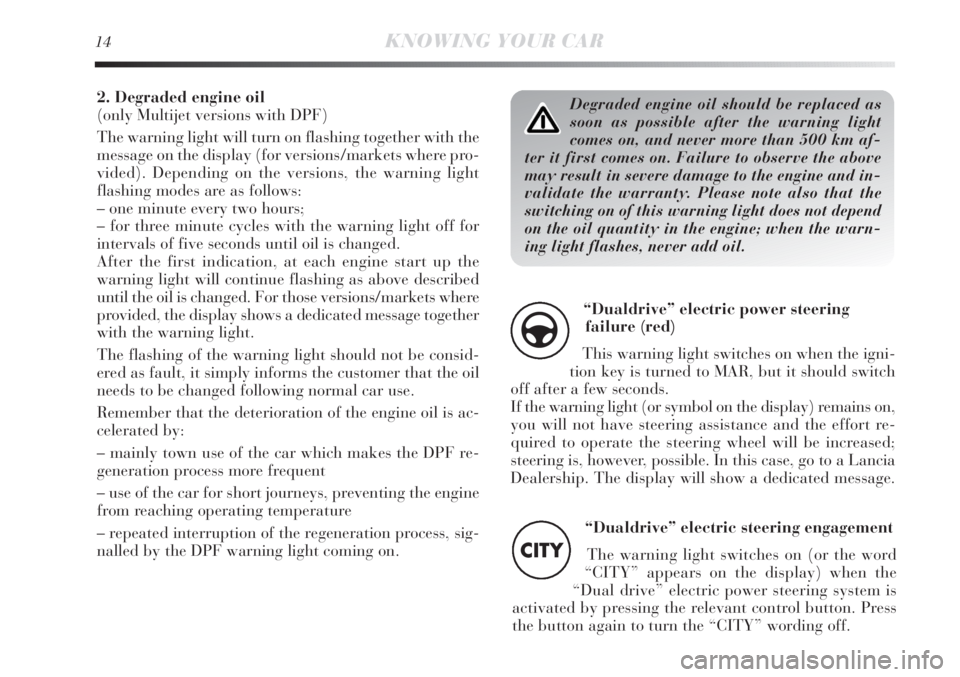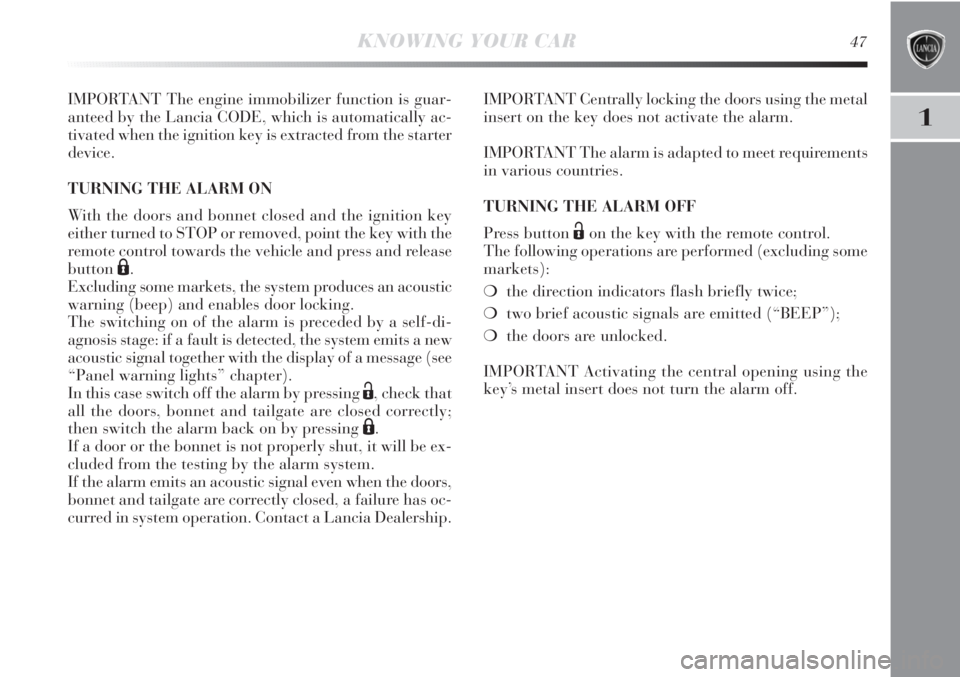tow Lancia Delta 2012 Owner handbook (in English)
[x] Cancel search | Manufacturer: LANCIA, Model Year: 2012, Model line: Delta, Model: Lancia Delta 2012Pages: 295, PDF Size: 8.29 MB
Page 16 of 295

Degraded engine oil should be replaced as
soon as possible after the warning light
comes on, and never more than 500 km af-
ter it first comes on. Failure to observe the above
may result in severe damage to the engine and in-
validate the warranty. Please note also that the
switching on of this warning light does not depend
on the oil quantity in the engine; when the warn-
ing light flashes, never add oil.
14KNOWING YOUR CAR
“Dualdrive” electric power steering
failure (red)
This warning light switches on when the igni-
tion key is turned to MAR, but it should switch
off after a few seconds.
If the warning light (or symbol on the display) remains on,
you will not have steering assistance and the effort re-
quired to operate the steering wheel will be increased;
steering is, however, possible. In this case, go to a Lancia
Dealership. The display will show a dedicated message.
g
“Dualdrive” electric steering engagement
The warning light switches on (or the word
“CITY” appears on the display) when the
“Dual drive” electric power steering system is
activated by pressing the relevant control button. Press
the button again to turn the “CITY” wording off.
CITY
2. Degraded engine oil
(only Multijet versions with DPF)
The warning light will turn on flashing together with the
message on the display (for versions/markets where pro-
vided). Depending on the versions, the warning light
flashing modes are as follows:
– one minute every two hours;
– for three minute cycles with the warning light off for
intervals of five seconds until oil is changed.
After the first indication, at each engine start up the
warning light will continue flashing as above described
until the oil is changed. For those versions/markets where
provided, the display shows a dedicated message together
with the warning light.
The flashing of the warning light should not be consid-
ered as fault, it simply informs the customer that the oil
needs to be changed following normal car use.
Remember that the deterioration of the engine oil is ac-
celerated by:
– mainly town use of the car which makes the DPF re-
generation process more frequent
– use of the car for short journeys, preventing the engine
from reaching operating temperature
– repeated interruption of the regeneration process, sig-
nalled by the DPF warning light coming on.
Page 18 of 295

16KNOWING YOUR CAR
❍if the vehicle is used under demanding conditions (e.g.
towing trailers uphill or fully loaded): slow down and,
if the light stays on, stop the car. Wait for 2 or 3 min-
utes with the engine running and slightly accelerated
to further accelerate the coolant circulation. Then stop
the engine. Check the correct liquid level as described
above.
IMPORTANT Over demanding routes, it is advisable to
keep the engine on and slightly accelerated for a few min-
utes before switching it off.
The display will show a dedicated message.
Doors not closed correctly (red)
This warning light switches on when one or
more doors are not properly shut. An acoustic
signal is activated with the doors open and the
car moving. The warning light in the multifunction dis-
play also switches on when the bonnet and/or tailgate are
not properly shut. The display will show a dedicated mes-
sage.
´
General failure indication (amber)
Fuel cut-off activated
This warning light (or symbol on the display)
switches on when the fuel cut off system inter-
venes. The display shows the dedicated message.
Engine oil pressure sensor failure
This warning light (or symbol on the display) switches on
when a failure is detected in the engine oil pressure sen-
sor. The display shows the dedicated message.
Dusk sensor failure
This warning light (or symbol on the display) switches on
when a failure is detected in the dusk sensor.
Speed limit exceeded
This warning light (amber), or symbol on the display
(red), switches on when the preset speed limit is exceeded
(for Arab countries the speed limit is set at 120 km/h).
The display shows the dedicated message.
Rain sensor fault
(for versions/markets, where provided)
This warning light (or symbol on the display) switches on
when a fault is detected in the rain sensor. The display
shows the dedicated message.
Start&Stop fault
(for versions/markets, where provided)
(versions with multifunction display)
The warning light comes on when a failure is detected in
the Start&Stop system. The display will show a dedicated
message.
è
Page 40 of 295

38KNOWING YOUR CAR
TRIP COMPUTER
GENERAL INFORMATION
The Trip computer is used to display information on car
operation when the key is turned to MAR. This function
is composed by separate trips, called “Trip A” and “Trip
B” which can monitor the entire mission (journey) in
a reciprocally independent manner.
Both functions can be reset (reset means start of a new
journey). “Trip A” is used to display the figures relating to:
– Range
– Trip distance
– Average consumption
– Current consumption
– Average speed
– Trip time (driving time)
– Trip A Reset
“Trip B” may be used to display the figures relating to:
– Trip distance B
– Average consumption B
– Average speed B
– Trip time B (driving time)
– Trip B Reset
N.B. “Trip B” may be disabled (see “Activating Trip B”).
“Range” and “Instant consumption” parameters cannot
be reset.Values displayed
Range
This indicates the approximate distance which can be
travelled with the present amount of fuel in the tank. The
display will show the reading ‘----’ when the following
events take place:
– range value lower than 50 km (or 30 mi)
– car parked with engine running for long period.
IMPORTANT The range can be affected by several fac-
tors: driving style (see “Driving style” in the “Starting
and driving” section), type of route (motorway, towns
and cities, mountain roads, etc.), conditions of use (load,
tyre pressures, etc.). Trip planning must therefore take
the above into account.
Distance travelled
This indicates the approximate distance covered from the
start of the new mission.
Page 49 of 295

1
KNOWING YOUR CAR47
IMPORTANT The engine immobilizer function is guar-
anteed by the Lancia CODE, which is automatically ac-
tivated when the ignition key is extracted from the starter
device.
TURNING THE ALARM ON
With the doors and bonnet closed and the ignition key
either turned to STOP or removed, point the key with the
remote control towards the vehicle and press and release
button
Á.
Excluding some markets, the system produces an acoustic
warning (beep) and enables door locking.
The switching on of the alarm is preceded by a self-di-
agnosis stage: if a fault is detected, the system emits a new
acoustic signal together with the display of a message (see
“Panel warning lights” chapter).
In this case switch off the alarm by pressing
Ë, check that
all the doors, bonnet and tailgate are closed correctly;
then switch the alarm back on by pressing
Á.
If a door or the bonnet is not properly shut, it will be ex-
cluded from the testing by the alarm system.
If the alarm emits an acoustic signal even when the doors,
bonnet and tailgate are correctly closed, a failure has oc-
curred in system operation. Contact a Lancia Dealership.IMPORTANT Centrally locking the doors using the metal
insert on the key does not activate the alarm.
IMPORTANT The alarm is adapted to meet requirements
in various countries.
TURNING THE ALARM OFF
Press button
Ëon the key with the remote control.
The following operations are performed (excluding some
markets):
❍the direction indicators flash briefly twice;
❍two brief acoustic signals are emitted (“BEEP”);
❍the doors are unlocked.
IMPORTANT Activating the central opening using the
key’s metal insert does not turn the alarm off.
Page 51 of 295

1
KNOWING YOUR CAR49
IGNITION DEVICE
The key can be turned to 3 different positions fig. 15:
❍STOP: engine off, key can be removed, steering
locked. Some electrical devices (e.g. sound system,
central door locking system, etc.) can operate.
❍MAR: driving position. All electrical devices can op-
erate.
❍AVV: engine starting.
The ignition switch is fitted with a safety system that re-
quires the ignition key to be turned back to STOP if the
engine does not start before the starting operation can be
repeated.STEERING LOCK
Engagement
When the key is at STOP, remove the key and turn the
steering wheel until it locks.
Disengagement
Move the steering wheel slightly as you turn the ignition
key to MAR.
IMPORTANT In some parking conditions (e.g.: wheels
turned) the effort required to move the steering wheel and
disengage the steering lock may be increased.
fig. 15L0E0107m
Never remove the key while the car is mov-
ing. The steering wheel would automatically
lock as soon as you try to turn it. This also
applies to when the car is towed. Under no cir-
cumstances should aftermarket operations be car-
ried out involving steering system or steering col-
umn modifications (e.g. installation of anti-theft
device). This could negatively affect performance
and safety, invalidate the warranty, cause serious
safety problems and also result in non-compliance
of the car with type-approval requirements.
Page 59 of 295

1
KNOWING YOUR CAR57
MANUAL CLIMATE CONTROL SYSTEM
L0E0017mfig. 25
CONTROLS fig. 25
A. Air temperature knob (red = hot/blue = cold)
B. Fan speed knob.
C. Air distribution knob
μtoward the body and the side windows
∑toward the body, the side windows and the feet∂toward the feet only
∏toward the feet and the windscreen
-toward the windshield only.
Page 69 of 295

1
KNOWING YOUR CAR67
DIPPED HEADLIGHTS/SIDE LIGHTS
With the ignition key turned to MAR, turn the twist
switch to 2. If the dipped beam headlights are activated,
the day lights are switched off and the side lights, dipped
headlights and number plate lights are switched on. The
warning light
3on the instrument panel comes on.
When the ignition key is turned to STOP or removed and
the twist switch is turned from
Oto2, all the side lights
and taillights and number plate lights come on. The
warning light
3in the instrument panel comes on.
Parking function
With the side lights on and the ignition key in the STOP
position or extracted, it is possible to select the lighting
on the desired side by operating the lights lever down-
wards (left side) or upwards (right side). In this case the
warning light
3in the instrument panel will go out.
MAIN BEAM HEADLIGHTS
With ring nut in position 2, push the stalk forward toward
the dashboard (stable position). The warning light 1on
the instrument panel will come on. They are switched off
by pulling the lever towards the steering wheel.
Flashing the headlights
You can flash the beams by pulling the stalk toward the
steering wheel (unstable position). The warning light
1
on the instrument panel will come on.DIRECTION INDICATORS fig. 28
Place the lever in the (stable) position:
– up (position
a): activates the right direction indicator;
– down (position
b): activates the left direction indicator.
The warning light
¥orÎstars flashing on the instrument
panel. The indicators switch off automatically when the
steering wheel is straightened.
fig. 28L0E0020m
Page 70 of 295

68KNOWING YOUR CAR
LANE CHANGE FUNCTION
If you wish to signal a lane change, place the left lever
in the unstable position for less than half a second. The
direction indicator on the side selected will flash five
times and then switch off automatically.
“FOLLOW ME HOME” DEVICE
This allows the space surrounding the car to be lit up for
a certain period of time.
Activation
With the ignition key in the STOP position or extracted,
pull the stalk towards the steering wheel and move it
within 2 minutes of the engine switching off. At each sin-
gle movement of the stalk, the lights will remain on for
an extra 30 seconds up to a maximum of 210 seconds;
then the lights are switched off automatically. Each time
the lever is operated, the warning light 3 on the instru-
ment panel comes on and the display shows how long the
function will remain active. The warning light comes on
when the stalk is pulled for the first time and stays lit un-
til the function switches itself off automatically. Each time
the stalk is activated the time will extend the time that
the lights remain on.
Deactivation
Keep the stalk pulled towards the steering wheel for more
than 2 seconds.WINDOW WASHING
The right-hand lever fig. 29 controls windscreen wiper/
washer and heated rear window wiper/washer operation.
WINDSCREEN WIPER/WASHER fig. 29
This operates only with the ignition key turned to MAR.
The right hand lever can take up five different positions:
A: windscreen wiper off.
B: intermittent operation.
With the lever in position B, turn control F to select one
of four different speeds for the intermittent operation
mode:
,= very slow intermittent operation
■= slow intermittent operation.
■■= normal intermittent operation
■■■= fast intermittent operation.
C: continuous slow operation;
D: continuous fast operation;
E: temporary fast operation (unstable position).
Page 71 of 295

1
KNOWING YOUR CAR69
“Smart washing” function
Pull the stalk towards the steering wheel (unstable po-
sition) to operate the windscreen washer. Keep the lever
pulled to activate both the windscreen washer jet and the
windscreen wiper with a single movement; the latter
turns on automatically if you keep the lever pulled for
over half a second. The windscreen wiper stops operat-
ing a few strokes after releasing the stalk; a further
“cleaning stroke”, after a few seconds, completes the
wiping operation.
fig. 29L0E0021m
REAR WINDOW WASHER/ WIPER
This operates only with the ignition key turned to MAR.
Turn the ring nut to
'to operate the rear window wiper.
With the windscreen wiper on, turn the ring nut to
'to
turn on the rear window wiper. In this case the wiper
works (in the different positions) timed with the wind-
screen wiper, but at half speed. With the windscreen
wiper on, engaging reverse gear will automatically turn
the rear window wiper on, in continuous slow operation.
Operation stops when reverse is disengaged.
Do not use the windscreen or rear window
wiper to remove layers of snow or ice from
the windscreen. In these conditions, the
windscreen wipers may be submitted to excessive
effort resulting in motor protection cutting in and
wiper operation inhibition for a few seconds. If the
issue persists, contact a Lancia Dealership.
“Smart washing” function
Pushing the stalk towards the dashboard (unstable po-
sition) will activate the rear window washer.
Keep the stalk pressed, with just one movement, to op-
erate the rear window washer jet and the rear window
wiper itself; the latter automatically turns on if you keep
the stalk pressed for more than half a second.
Page 73 of 295

1
KNOWING YOUR CAR71
Deactivation
Turn the ignition key to STOP.
The next time the vehicle is started (ignition key turned
to MAR), the sensor is not reactivated even if the lever is
still in position B-fig. 29. To activate the sensor, move the
lever to position A or C and then back to position B.
Rain sensor activation will be indicated by at least one
wiper “stroke” even if the windscreen is dry.CRUISE CONTROL
(constant speed regulator)
(for versions/markets, where provided)
This is an electronically controlled driving assistance de-
vice which allows the vehicle to be driven at a chosen
speed above 30 km/h on long stretches of dry, straight
roads with few variations (e.g. motorways), without hav-
ing to depress the accelerator pedal.
It is therefore not recommended to use this device on
country roads with traffic. Do not use it in town.
TURNING THE DEVICE ON
Turn the ring nut A-fig. 31 to ON.
The device must only be switched on in gears higher than
4t
h.
Do not activate the rain sensor when wash-
ing the car in an automatic car wash.
Make sure the device is switched off if there
is ice on the windscreen.
Make sure the device is switched off when-
ever the windscreen is being cleaned.
fig. 31L0E0022m